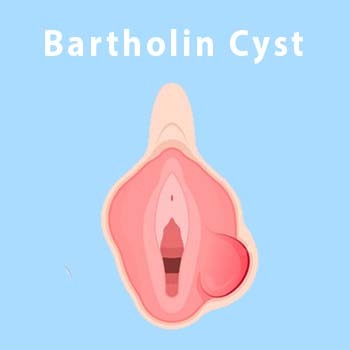BARTHOLIN CYST
-
What is a Bartholin cyst?
A Bartholin cyst (or vulvar cyst) is a type of vaginal cyst that forms on either side of the labia (vaginal lips) near the opening of the vagina. It's named after the Bartholin glands, which are two small glands that produce the fluid (mucus) that help lubricate the vagina. The labia and Bartholin's glands are part of the vulva in the female reproductive system.
A Bartholin cyst occurs when a blockage happens at the openings of one of these glands, causing the mucus to build up and form a lump. It typically only occurs on one of the two Bartholin glands. Some I3artholin cysts are small and don't cause any pain. If the cyst becomes infected with bacteria, an abscess can form. When infected, Bartholin cysts can be painful and may require medical treatment.
-
What does a Bartholin cyst look like?
Bartholin cysts will look like round bumps under the skin on the lips of your vagina (labia). They’re often painless. Some may become red, tender and swollen if an infection occurs. Other Bartholin cysts may look like they are filled with pus or fluid. Bartholin cysts can be as small as a pea or grow as large as a golf ball. The cyst may make one side of your labia appear larger or look lopsided.
-
Who gets Bartholin cysts?
They are more common in women of reproductive age.
-
What causes a Bartholin cyst?
Healthcare providers do not know why some women are predisposed to getting Bartholin cysts. Some causes of Bartholin cysts are:
Injury, irritation or extra growth of skin in the vulvar area of the vagina.
Chlamvdia, gonorrhea or other sexually transmitted infections (STIs).
Bacterial infections such as Escherichia (E. coli).
-
What are the symptoms of a Bartholin cyst?
Many Bartholin cysts are small and do not cause symptoms other than minor irritation. If a Bartholin cyst forms an abscess (infection), symptoms may include:
Discomfort and pain during sex, walking, sitting, or when inserting a tampon or wiping after using the restroom.
Swelling and tenderness in the area.
Fever or chills.
Redness.
Drainage from the cyst.
Change in size (the cyst gets larger).
-
How is a Bartholin cyst diagnosed?
To diagnose a Bartholin cyst, gynecologist will do a physical exam. They will look at the size of the cyst and look for signs of infection. If the cyst produces discharge, your healthcare provider may test the fluid for sexually transmitted infections (STIs) or other bacterial infections.
-
Are there any other tests done to diagnose Bartholin cysts?
In women older than age 40, healthcare providers may perform a test called a biospy to rule out cancer of the vulva. During this test, your healthcare provider will remove a small sample of tissue from the cyst and look at it under a microscope.
A Bartholin gland cyst may need to be surgically removed if your healthcare provider feels it may be cancerous. It’s rare for cancer to develop in the Bartholin gland, however, it’s more common if you are over the age of 60.
-
What are the treatments for a Bartholin cyst?
Sitz baths: Sit in a bathtub with 3 to 4 inches of warm water a few times a day for several days. This can provide comfort and promote healing.
Over-the-counter pain medications
Antibiotics: If your cyst becomes infected or tests show you have a sexually transmitted infection (STI), your gynecologist may prescribe antibiotics.
Surgical draining: If your cyst is large and infected, surgery may be done to drain the fluid.
Marsupialization: The cyst is surgically opened and drained. Then, the surgeon will stitch the edges of the cyst wall to form a permanent open pocket or "pouch" for continuous drainage. This is often helpful for recurrent Bartholin cysts.
Removal of the Bartholin's gland: In extremely rare cases where treatment is not working, your healthcare provider may surgically remove the Bartholin glands.
Symptoms and Causes
Diagnosis and Tests
Management and Treatment

